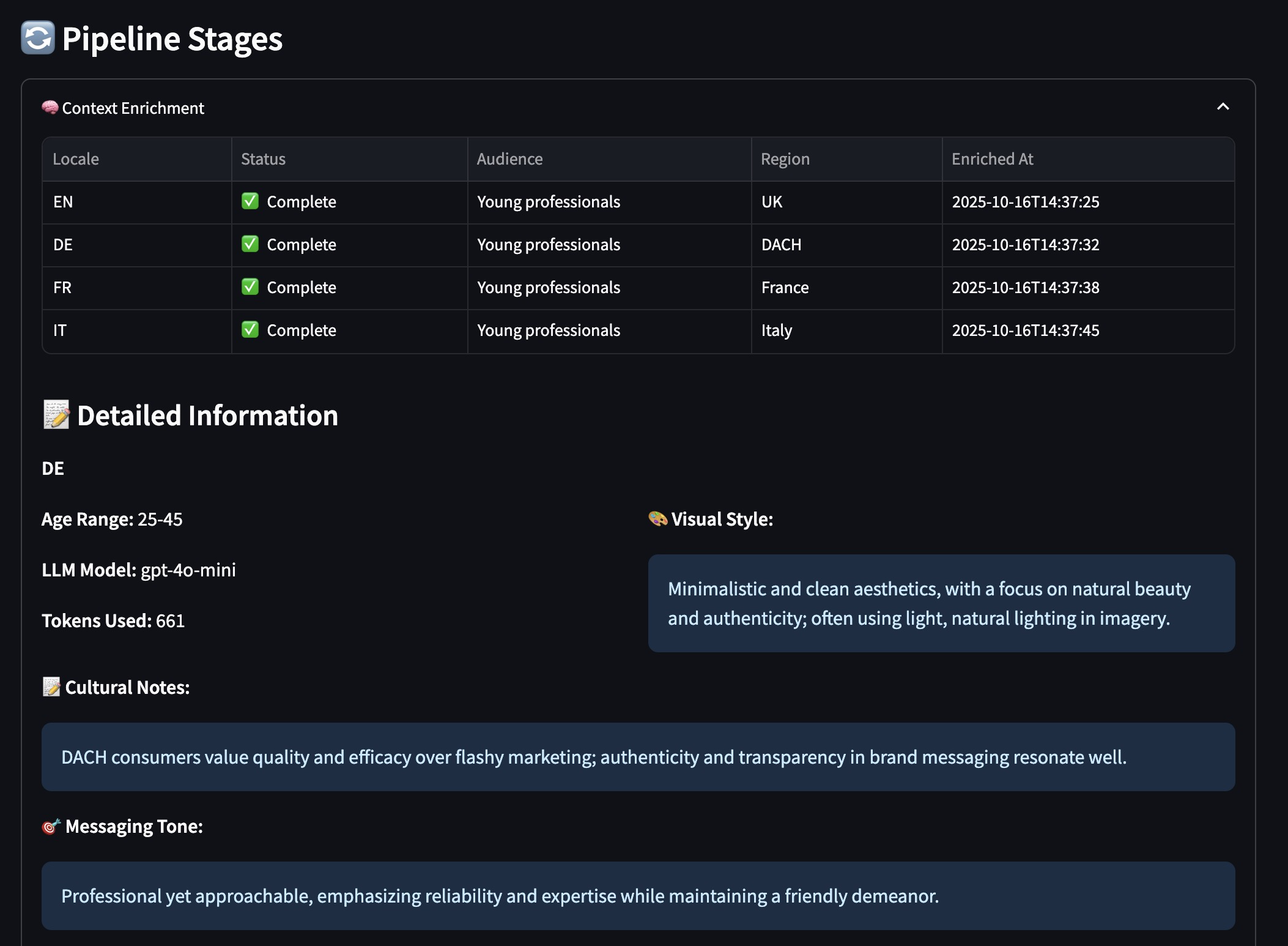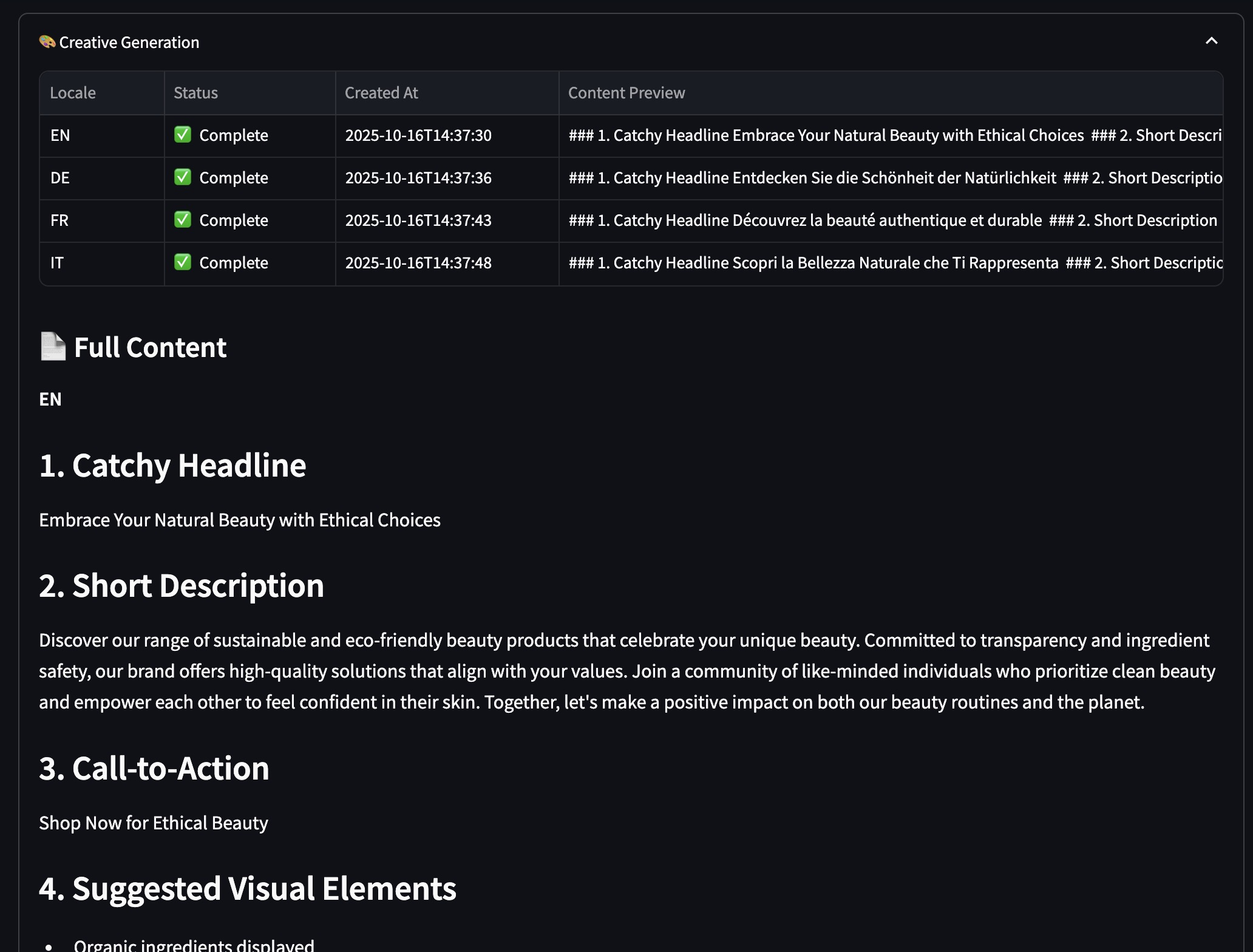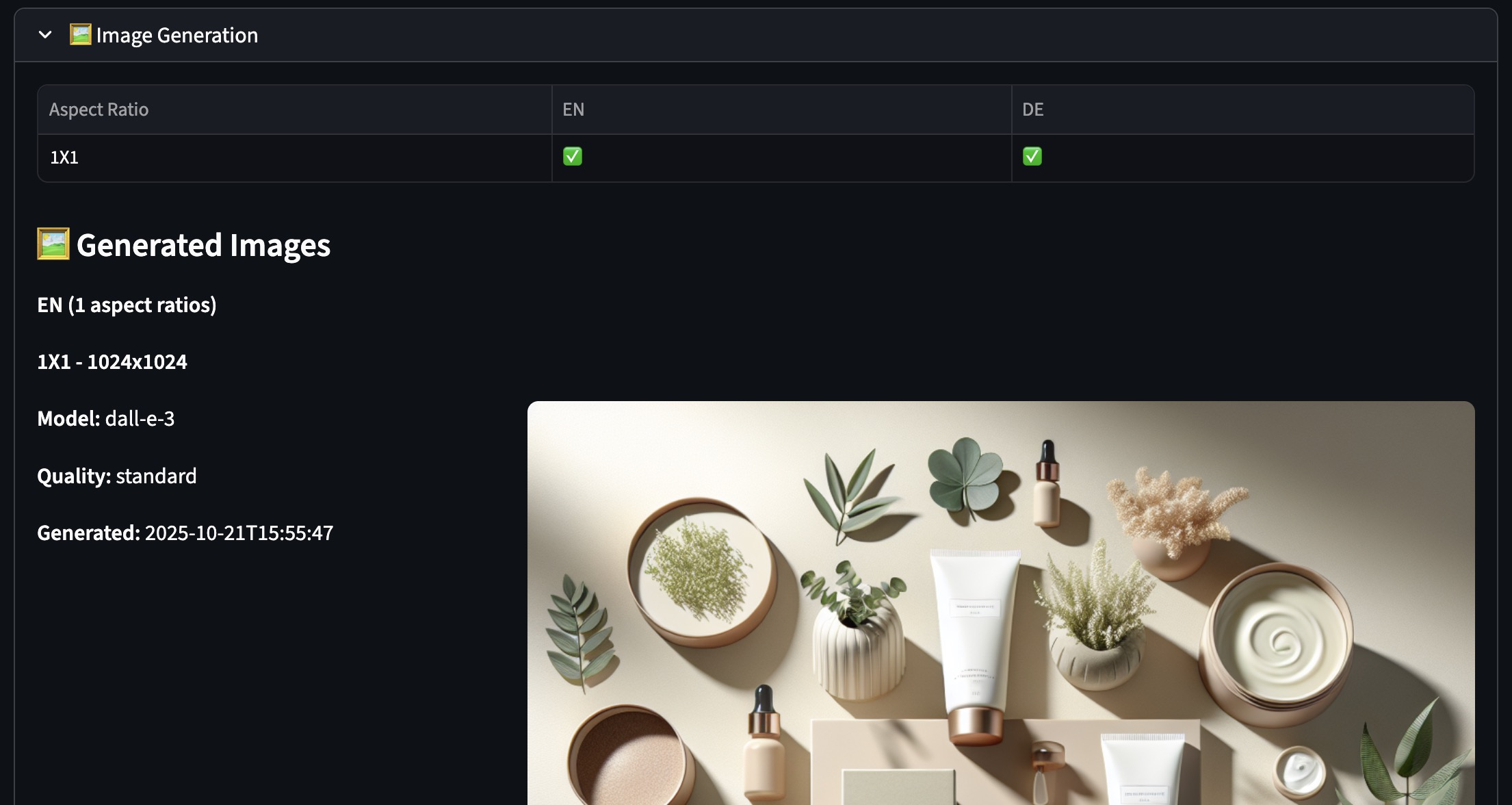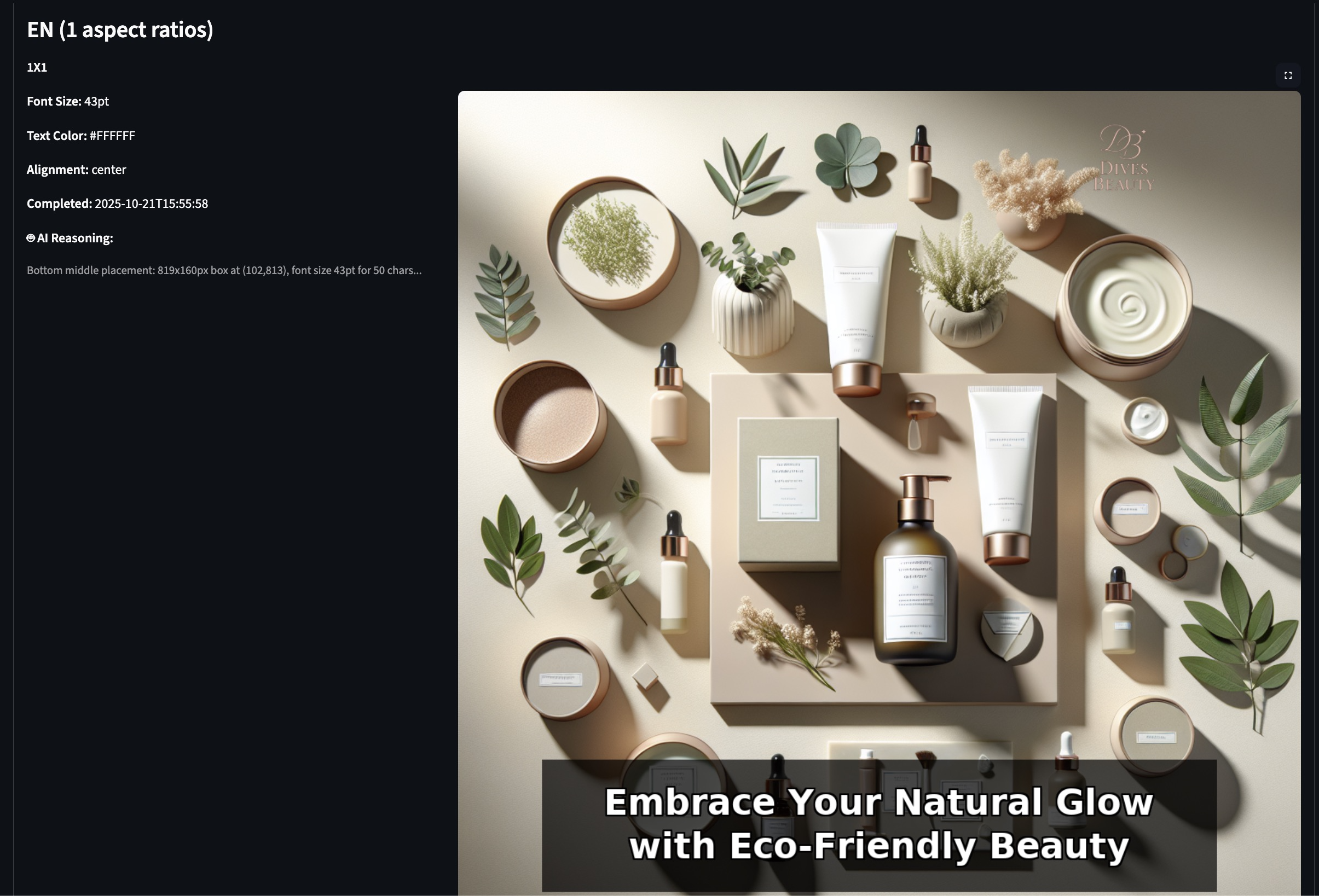Building an AI-Powered Creative Campaign Pipeline: From Brief to Assets in Minutes
The marketing automation problem hasn’t changed: creative teams spend days generating localized ad variants across markets and formats. A single campaign with 2 products × 4 locales × 4 aspect ratios = 32 unique assets. Each needs culturally-appropriate copy, branded visuals, and format-specific composition.
CreativeCampaign-Agent automates this end-to-end using event-driven microservices and OpenAI APIs. From campaign brief to production-ready assets in under 10 minutes.
GitHub: github.com/gsantopaolo/CreativeCampaign-Agent
The Problem: Manual Creative Work Doesn’t Scale
Imagine you’re launching a beauty campaign across 4 markets (EN, DE, FR, IT) with 2 products and 4 aspect ratios (1:1, 4:5, 9:16, 16:9). That’s 32 unique creative assets. Each needs:
- ✍️ Localized copy respecting cultural nuances and legal guidelines
- 🎨 Product images optimized for each aspect ratio
- 🏷️ Brand elements (logo, colors) intelligently placed
- 📝 Text overlays positioned for maximum impact
Manual approach:
- Creative team: 2 days writing localized copy
- Designers: 3 days positioning logos and exporting variants
- QA: 1 day checking brand compliance
Total: 6+ days, $5,000-$10,000, zero scalability.
The Solution: Event-Driven AI Pipeline
CreativeCampaign-Agent automates the entire workflow:
- GPT-4o-mini for cultural context, creative copy, and AI vision-based logo placement
- DALL-E 3 for aspect-ratio-optimized product images
- NATS JetStream for reliable event-driven orchestration
- MongoDB + S3 for persistence
- Docker Compose for one-command deployment
Result: 32 variants in under 10 minutes, ~$1.20 in API costs.
System Architecture
Event-driven microservices orchestrated via NATS JetStream:
graph TB
subgraph "User Interface"
UI[Streamlit Web UI<br/>Campaign Creation]
end
subgraph "API Layer"
API[API Gateway<br/>FastAPI + REST]
end
subgraph "Event Bus"
NATS[NATS JetStream<br/>Reliable Messaging]
end
subgraph "Worker Services"
CE[Context Enricher<br/>GPT-4o-mini]
CG[Creative Generator<br/>GPT-4o-mini]
IG[Image Generator<br/>DALL-E 3]
BC[Brand Composer<br/>GPT-4o-mini Vision]
TO[Text Overlay<br/>PIL/Pillow]
end
subgraph "Storage"
S3[MinIO/S3]
MONGO[MongoDB]
end
subgraph "External"
OPENAI[OpenAI API]
end
UI -->|HTTP| API
API --> NATS
NATS --> CE --> NATS
NATS --> CG --> NATS
NATS --> IG --> NATS
NATS --> BC --> NATS
NATS --> TO --> NATS
CE & CG & IG & BC --> OPENAI
IG & BC & TO --> S3
CE & CG & IG & BC & TO <--> MONGO
Five specialized services, each with a single responsibility. Let’s walk through the pipeline.
Service 1: Context Enricher
Purpose: Generate locale-specific cultural insights to inform creative generation.
What It Does
For each locale, it generates:
- Cultural notes and sensitivities
- Appropriate messaging tone
- Visual style preferences
- Do’s and don’ts for the market
- Legal/compliance guidelines
Sequence Diagram
sequenceDiagram
participant API as API Gateway
participant NATS as NATS JetStream
participant CE as Context Enricher
participant OpenAI as OpenAI<br/>(GPT-4o-mini)
participant DB as MongoDB
API->>NATS: Publish context.enrich.request
Note over API: campaign_id: "summer-2025"<br/>locale: "de"<br/>region: "DACH"
NATS->>CE: Deliver message
CE->>CE: Build LLM prompt
Note over CE: Include audience, age range,<br/>region, products
CE->>OpenAI: Generate context pack
OpenAI-->>CE: Cultural insights (JSON)
CE->>DB: Save context pack
CE->>NATS: Publish context.enrich.ready
Note over CE,NATS: Includes full context_pack
CE->>NATS: ACK
Example Output (German Market)
1
2
3
4
5
6
7
8
9
10
11
12
13
14
15
16
{
"locale": "de",
"culture_notes": "DACH region values precision, quality, and scientific backing. Consumers are detail-oriented and appreciate transparency in ingredients and manufacturing processes.",
"tone": "professional yet approachable",
"dos": [
"Emphasize product quality and efficacy",
"Use formal 'Sie' initially",
"Highlight natural ingredients with specifics"
],
"donts": [
"Avoid overly casual language",
"Don't make unsubstantiated health claims",
"Avoid aggressive sales tactics"
],
"legal_guidelines": "Must comply with EU cosmetics regulations..."
}
Code: src/context_enricher/main.py
Service 2: Creative Generator
Purpose: Generate localized creative content in the target language using the enriched context.
What It Does
Generates in the target language:
- Catchy headline (5-15 words)
- Campaign description (50-100 words)
- Call-to-action (3-8 words)
- Suggested visual elements
Sequence Diagram
sequenceDiagram
participant CE as Context Enricher
participant NATS as NATS JetStream
participant CG as Creative Generator
participant OpenAI as OpenAI<br/>(GPT-4o-mini)
participant DB as MongoDB
CE->>NATS: Publish context.enrich.ready
NATS->>CG: Deliver with context_pack
CG->>DB: Fetch brand guidelines
CG->>CG: Build localized prompt
Note over CG: Prompt in English,<br/>Output in German
CG->>OpenAI: Generate creative content
OpenAI-->>CG: Structured JSON (German text)
CG->>CG: Validate with Pydantic
CG->>DB: Save creative content
CG->>NATS: Publish creative.generate.done
CG->>NATS: ACK
Example Output (German)
1
2
3
4
5
6
{
"headline": "Natürliche Schönheit jeden Tag",
"description": "Entdecken Sie unsere premium Hautpflege-Kollektion mit natürlichen Inhaltsstoffen. Vitamin C Serum und Hydration Cream für strahlende, gesunde Haut. Wissenschaftlich getestet, dermatologisch bestätigt.",
"call_to_action": "Jetzt entdecken",
"visual_elements": ["Natürliche Inhaltsstoffe", "Elegante Produktverpackung"]
}
Key: All content is in the target language (German), respecting cultural context from the enricher.
Code: src/creative_generator/main.py
Service 3: Image Generator
Purpose: Generate product images using DALL-E 3 with aspect-ratio-specific prompts.
What It Does
Generates 4 images per locale, each optimized for its aspect ratio:
- 1x1 - Square (Instagram feed) - centered composition
- 4x5 - Portrait (Instagram) - vertical flow, product in upper portion
- 9x16 - Story (Instagram/TikTok) - dramatic vertical, product top/center
- 16x9 - Landscape (YouTube) - wide cinematic, product left or right
Each format gets customized composition guidance in the DALL-E prompt.
Sequence Diagram
sequenceDiagram
participant CG as Creative Generator
participant NATS as NATS JetStream
participant IG as Image Generator
participant OpenAI as DALL-E 3
participant S3 as MinIO/S3
participant DB as MongoDB
CG->>NATS: Publish creative.generate.done
NATS->>IG: Deliver message
IG->>DB: Fetch campaign (aspect ratios)
loop For each aspect ratio (4x)
IG->>IG: Build aspect-specific prompt
Note over IG: 1x1: "centered composition"<br/>9x16: "vertical story format"
IG->>OpenAI: Generate image
Note over IG,OpenAI: Size: 1024x1024,<br/>1024x1792, or 1792x1024
OpenAI-->>IG: Image URL
IG->>OpenAI: Download image
OpenAI-->>IG: PNG data
IG->>S3: Upload
Note over IG,S3: campaigns/{id}/{locale}/<br/>{aspect}/generated_*.png
IG->>DB: Save metadata
IG->>NATS: Publish image.generated
Note over IG,NATS: One event per aspect ratio
end
IG->>NATS: ACK
Aspect-Ratio-Specific Prompts
1
2
3
4
5
6
7
# Each aspect ratio gets different composition guidance
composition_guidance = {
"1x1": "centered composition with balanced symmetry, product prominently displayed in middle third",
"4x5": "vertical portrait composition with product in upper two-thirds, space at bottom for text",
"9x16": "tall vertical story format with product in center or upper portion, generous bottom space",
"16x9": "wide horizontal landscape with product positioned left or right, space for text on opposite side"
}
Critical: Images have NO text (text overlay happens later) and leave strategic space for logo (top half) and text (bottom half).
Code: src/image_generator/main.py
Service 4: Brand Composer (AI Logo Placement)
Purpose: Add brand logo using GPT-4o-mini Vision to intelligently determine optimal placement.
The Innovation: AI Vision for Logo Placement
Traditional systems use fixed positions (“top-right corner”). This can cover products, faces, or look unnatural.
CreativeCampaign-Agent uses AI vision analysis:
- Sends image to GPT-4o-mini Vision
- AI analyzes image composition, identifies products/faces/focal points
- AI finds empty space with good contrast in upper 50% (text goes in bottom 50%)
- Returns position, size, and detailed reasoning
Sequence Diagram
sequenceDiagram
participant IG as Image Generator
participant NATS as NATS JetStream
participant BC as Brand Composer
participant OpenAI as GPT-4o-mini<br/>Vision
participant S3 as MinIO/S3
participant DB as MongoDB
IG->>NATS: Publish image.generated
NATS->>BC: Deliver message
BC->>DB: Fetch brand config
Note over BC,DB: logo_s3_uri,<br/>primary_color
BC->>S3: Download generated image
S3-->>BC: Image data
BC->>BC: Convert image to base64
BC->>OpenAI: Analyze for logo placement
Note over BC,OpenAI: Send: image + dimensions<br/>Request: optimal position<br/>in upper 50%
OpenAI-->>BC: Placement analysis (JSON)
Note over BC: position: "top_right"<br/>x_percent: 0.85<br/>y_percent: 0.12<br/>scale: 0.12<br/>reasoning: "..."
BC->>S3: Download logo
S3-->>BC: Logo PNG/RGBA
BC->>BC: Resize logo to scale
BC->>BC: Calculate pixel coordinates
BC->>BC: Composite logo (preserve transparency)
BC->>S3: Upload branded image
Note over BC,S3: campaigns/{id}/{locale}/<br/>{aspect}/branded_*.png
BC->>DB: Save metadata + reasoning
BC->>NATS: Publish brand.composed
BC->>NATS: ACK
AI Vision Prompt (Simplified)
1
2
3
4
5
6
7
8
9
10
11
12
13
14
15
16
17
18
19
20
21
22
Analyze this {width}x{height}px product image.
CONSTRAINT: Logo MUST be in UPPER HALF (y < 50%) because text goes at bottom.
Find optimal logo position that:
1. Doesn't cover products, faces, or key elements
2. Has good contrast and visibility
3. Feels natural and professional
Scan upper half, identify:
- Visual elements and pixel locations
- Empty spaces suitable for logo
- Best position: top-left, top-right, or top-center
Return JSON:
{
"position": "top_right",
"x_percent": 0.85,
"y_percent": 0.12,
"scale": 0.12,
"reasoning": "Top-right corner (x=870-980px, y=50-150px) has plain background. Product centered at 400-700px. Logo at scale 0.12 (123px) ensures visibility without obscuring elements."
}
Example AI Response
1
2
3
4
5
6
7
{
"position": "top_right",
"x_percent": 0.85,
"y_percent": 0.12,
"scale": 0.12,
"reasoning": "Top-right corner identified as optimal placement (x=870-980px, y=50-150px). Plain light background provides excellent contrast. Product imagery centered at 300-700px, face at 400-600px. Placing logo at (870, 123) with 12% scale ensures brand visibility without obscuring key visual elements. Confirmed y=123px is in top 12%."
}
Why AI instead of rules?
- ✅ Analyzes actual image content
- ✅ Adapts to each unique composition
- ✅ Finds empty spaces automatically
- ✅ Considers contrast
- ✅ Provides transparent reasoning
Cost: ~$0.001 per image (~$0.032 for 32 variants)
Code: src/brand_composer/main.py
Service 5: Text Overlay
Purpose: Add localized campaign text to branded images and export final assets.
What It Does
- Extracts headline from creative content
- Downloads branded image from S3
- Calculates text placement (code-based, not AI - bottom is predictable)
- Renders text with semi-transparent background
- Uploads final asset to S3
- Marks campaign as “completed” when all locales/aspects done
Sequence Diagram
sequenceDiagram
participant BC as Brand Composer
participant NATS as NATS JetStream
participant TO as Text Overlay
participant S3 as MinIO/S3
participant DB as MongoDB
BC->>NATS: Publish brand.composed
NATS->>TO: Deliver message
TO->>DB: Fetch creative content
Note over TO,DB: Get headline for locale
TO->>TO: Extract headline
Note over TO: Parse markdown:<br/>"### 1. Catchy Headline"
TO->>S3: Download branded image
S3-->>TO: Image data
TO->>TO: Calculate text placement
Note over TO: Bottom middle, 80% width,<br/>font size based on text length
TO->>TO: Wrap text to fit
TO->>TO: Draw semi-transparent background
Note over TO: Dark box, 70% opacity
TO->>TO: Render text with outline
Note over TO: White text, black outline,<br/>centered alignment
TO->>S3: Upload final image
Note over TO,S3: campaigns/{id}/{locale}/<br/>{aspect}/final_*.png
TO->>DB: Update campaign.outputs
TO->>DB: Check if all complete
alt All locales/aspects done
TO->>DB: Mark campaign "completed"
end
TO->>NATS: Publish text.overlaid
TO->>NATS: ACK
Text Placement Algorithm
1
2
3
4
5
6
7
8
9
10
11
12
13
14
15
16
17
18
19
20
21
def calculate_bottom_middle_placement(width, height, text):
# Font size: 5% of image width, adjusted for text length
base_font_size = int(width * 0.05)
font_size = adjust_for_length(base_font_size, len(text))
# Box: 80% width, centered
box_width = int(width * 0.8)
box_x = (width - box_width) // 2
# Position: 5% margin from bottom
margin_bottom = int(height * 0.05)
box_y = height - box_height - margin_bottom
return {
"box_x": box_x,
"box_y": box_y,
"font_size": font_size,
"text_color": "#FFFFFF", # White
"background_opacity": 0.7, # Semi-transparent dark
"alignment": "center"
}
Why code-based (not AI)?
- ✅ Logo already cleared bottom space (AI placed it in top half)
- ✅ Text always goes at bottom (predictable)
- ✅ Faster (no API call)
- ✅ $0 cost
- ✅ Consistent results
Code: src/text_overlay/main.py
Complete Pipeline in Action
For a campaign with 2 locales (EN, DE) × 4 aspect ratios = 8 final assets:
1
2
3
4
5
6
7
8
9
10
11
12
13
14
15
16
17
18
19
20
21
22
User submits campaign brief
↓
API → briefs.ingested → NATS
↓
Context Enricher (2 parallel: EN, DE)
→ context.enrich.ready (EN)
→ context.enrich.ready (DE)
↓
Creative Generator (2 parallel)
→ creative.generate.done (EN)
→ creative.generate.done (DE)
↓
Image Generator (8 parallel: 2 locales × 4 aspects)
→ image.generated × 8
↓
Brand Composer (8 parallel with AI vision)
→ brand.composed × 8
↓
Text Overlay (8 parallel)
→ text.overlaid × 8
↓
Campaign Status: COMPLETED
Timeline:
- Context enrichment: 10s per locale (parallel) = 10s total
- Creative generation: 15s per locale (parallel) = 15s total
- Image generation: 30s per image (sequential per locale) = 2-4 minutes total
- Brand composition: 8s per image (parallel) = 30s total
- Text overlay: 5s per image (parallel) = 15s total
Total: 5-8 minutes for 8 assets (or 8-12 minutes for 32 assets)
UI: Completed Campaign View
 Completed Campaign - Context Enrichment
Completed Campaign - Context Enrichment
 Completed Campaign - Creative Generation
Completed Campaign - Creative Generation
 Completed Campaign - Image Generation
Completed Campaign - Image Generation
 Completed Campaign - Brand Composition and Text Overlay (Final)
Completed Campaign - Brand Composition and Text Overlay (Final)
The Streamlit UI shows:
- ✅ All generated variants organized by locale and aspect ratio
- 🤖 AI placement reasoning for each logo
- 📊 Processing timeline and status
- 🔄 Option to regenerate specific variants
- 📥 Bulk download of all assets
Installation: Ridiculously Simple
You don’t even need to clone the repo.
Prerequisites
- Docker (Get Docker)
- OpenAI API key (Get one)
Run in 3 Commands
1
2
3
4
5
6
7
8
# 1. Download runner script
curl -O https://raw.githubusercontent.com/gsantopaolo/CreativeCampaign-Agent/main/deployment/run-creative-campaign.sh?utm_source=genmind.ch
# 2. Make executable
chmod +x run-creative-campaign.sh
# 3. Run with your OpenAI API key
./run-creative-campaign.sh sk-proj-YOUR-OPENAI-API-KEY-HERE
That’s it. The script:
- 🐳 Pulls Docker image from Docker Hub
- 🚀 Starts all services (API, workers, MongoDB, MinIO, NATS)
- ✨ Waits for readiness
- 🌐 Opens UI at http://localhost:8501
Time to running system: Under 2 minutes.
Full setup guide: docs/just-run.md
Cost Breakdown (32 variants)
- Context enrichment: $0.08 (GPT-4o-mini × 4 locales)
- Creative generation: $0.12 (GPT-4o-mini × 4 locales)
- Image generation: $1.28 (DALL-E 3 × 32 variants @ $0.04/image)
- Logo placement: $0.03 (GPT-4o-mini vision × 32)
- Total: ~$1.50 per campaign
Compare to manual: $5,000-$10,000.
ROI: 3,333x - 6,667x
Documentation
Comprehensive docs in the repo:
- Architecture Deep Dive
- Agentic System Design
- AI Logo Placement
- Implementation Patterns
- Why Microservices?
- Service Docs (Context Enricher, Creative Generator, Image Generator, Brand Composer, Text Overlay)
Final Thoughts
This isn’t a toy demo—it’s built like a real customer deployment. The architecture demonstrates production patterns you’d use at scale:
✅ Event-driven microservices for independent scaling
✅ AI-powered intelligence where it adds value
✅ Horizontal scaling with NATS queue groups
✅ Fault tolerance (retries, health checks, DLQ)
✅ Observable & reliable (structured logs, metrics)
Built in the spirit of a Forward Deployed Engineer’s 2-day customer POC—showing both technical depth and pragmatic engineering judgment.
If you’re building AI-powered automation or event-driven systems, I hope this serves as a useful reference architecture.
GitHub: github.com/gsantopaolo/CreativeCampaign-Agent
Questions? Open an issue on GitHub.